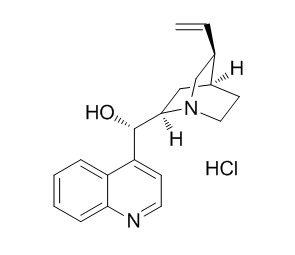Cinchonine hydrochloride
Reference standards.
Inquire / Order:
manager@chemfaces.com
Technical Inquiries:
service@chemfaces.com
Tel:
+86-27-84237783
Fax:
+86-27-84254680
Address:
1 Building, No. 83, CheCheng Rd., Wuhan Economic and Technological Development Zone, Wuhan, Hubei 430056, PRC
Providing storage is as stated on the product vial and the vial is kept tightly sealed, the product can be stored for up to
24 months(2-8C).
Wherever possible, you should prepare and use solutions on the same day. However, if you need to make up stock solutions in advance, we recommend that you store the solution as aliquots in tightly sealed vials at -20C. Generally, these will be useable for up to two weeks. Before use, and prior to opening the vial we recommend that you allow your product to equilibrate to room temperature for at least 1 hour.
Need more advice on solubility, usage and handling? Please email to: service@chemfaces.com
The packaging of the product may have turned upside down during transportation, resulting in the natural compounds adhering to the neck or cap of the vial. take the vial out of its packaging and gently shake to let the compounds fall to the bottom of the vial. for liquid products, centrifuge at 200-500 RPM to gather the liquid at the bottom of the vial. try to avoid loss or contamination during handling.
Biochem Biophys Res Commun.2018, 505(4):1148-1153
Biosci Biotechnol Biochem.2021, 85(10):2153-2160.
Phytother Res.2022, 35844057.
Evid Based Complement Alternat Med.2018, 2018:4259603
Research J. Pharm. and Tech.2020, 13(7):3059-3064.
Int J Mol Sci.2024, 25(23):12733.
Acta Pharm Sin B.2024, 14(4):1772-1786.
Biol Pharm Bull.2017, 40(6):797-806
Evid-Based Compl Alt2020, 7202519:13
Biorxiv2019, 10.1101
Related and Featured Products
Canadian Journal of Chemistry, 2011, 49(12):2161-2165.
A Study of the Pfeiffer Effect in Systems containing Trisoxalatometallate(III) Complexes and Cinchonine Hydrochloride[Reference:
WebLink]
METHODS AND RESULTS:
The Pfeiffer effect was studied in systems containing Cinchonine hydrochloride and trisoxalatometallate(III) complexes of Al, Fe, Cr, Co, and Ir. The Pfeiffer rotatory dispersion curves of the Cr and Co complexes show Cotton effects analogous to that observed in the optical rotatory dispersion (o.r.d.) curves of the respective complexes.
CONCLUSIONS:
The source of the Pfeiffer effect in all these systems is attributed either to an association between the complex ion and the optically active species in solution alone, as in the case of the Ir(lII) complex, or to a combination of this association and an "equilibrium shift" between the two enantiomers in solution in favor of one of them, as in the case of the other complexes under investigation.



